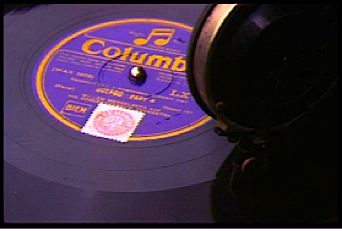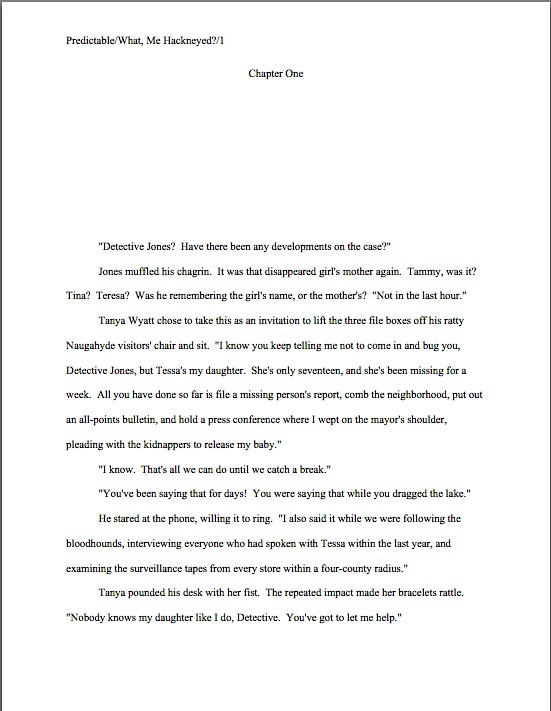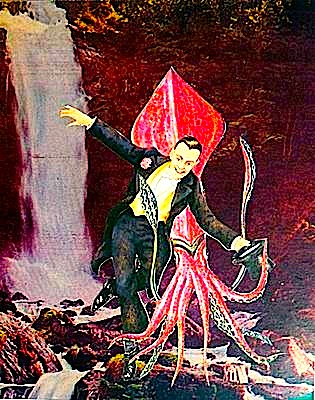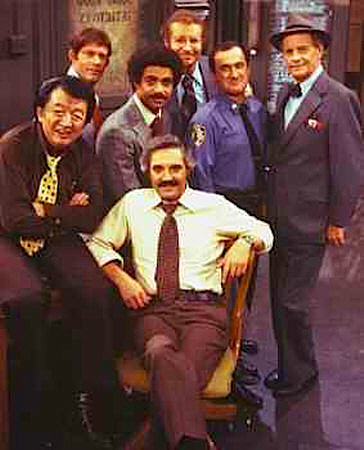On and off for the last couple of weeks, we’ve been talking about that graveyard of literary tension and promoter of telling rather than showing, the Short Road Home. The SRH haunts novel and memoir submissions in a variety of disguises. Oh, it’s a versatile narrative trick, easily applied to a broad range of manuscript environments; it is as proficient at strangling burgeoning character development as it is at draining the tension out of a scene.
Most often, of course, it manifests as a scene or plot that resolves conflict practically the nanosecond it appears — astonishingly often without any effort whatsoever on the part of the protagonist. Indeed, conflict-avoidance is so popular amongst fictional characters that protagonists tend to favor resisting the status quo even in their minds.
Oh, you may laugh, but you’d be surprised how often those of us who read for a living will watch, stunned, as a protagonist briefly considers perhaps maybe eventually doing or saying something — only to be interrupted by another character rushing in to prevent even the thought of discord from developing into something that might be interesting for the reader to watch. The swiftness with which these tension-averse white knights dispatch nascent conflict is sometimes downright eerie, begging the question: is this character a participant in this story, or is he reading it?
You’d like a concrete example, wouldn’t you? We aim to please.
If only I had the courage to speak up, Tyrone thought, seething. I’ve put up with my repressive boss’ arbitrary pronouncements for years. Maybe today is the day I should stop being a doormat. Maybe today is the day I shall start speaking up for myself. Maybe today is…
“Oh, and before we end the meeting,” Artie said, smoothing his notes, “I’ve been sensing some disgruntlement in the face of our recent reorganization. Perhaps I’ve been a trifle, well, if not insensitive, then at least myopic. I’d like to hear your concerns, though.” He turned to Tyrone. “I’ve always valued your opinion, Ty. How do you think we could improve our beloved department?”
Beaming, Tyrone wrestled a binder stuffed with suggestions from his backpack. “I thought you’d never ask!”
Ah, but the reader wishes you hadn’t asked, Artie. Characters who read one another’s minds are notorious tension-deflaters.
They are also prone to cutting off plot possibilities before they have a chance to do more than poke their wary heads above ground. Had Artie not magically deduced his employees’ irritation from some clue that the narrative has not elected to share with the reader — if, in other words, the conflict were shown by any means other than Tyrone’s thoughts telling us about them — maybe then Tyrone would have had to take the longer, more arduous road of addressing the problem by — wait for it — addressing the problem. As in out loud, in a manner that might have provoked an interesting, true-to-life scene.
We met another favorite guise of the Short Road Homes in my last post: telling a story out of chronological order, drowning any possible suspense about the outcome of a conflict by revealing it at the beginning of the scene, rather than the end. Even if foreshadowing is vague, it can sap the reader’s impetus to wonder what is going to happen next — a pity, really, as its purpose is ostensibly to raise suspense.
All too soon, our happy mood vanished, ruining the rest of the day. If I’d known what was going to happen next, I would have grabbed the oars and rowed like mad for the shore.
“Where’s the sun gone?” Barbara asked suddenly.
Meg’s hat blew off before she could reply. “The sky looks mighty ominous. I’d always thought that the clouds spelled DOOM was just an expression.”
I pointed a shaking finger over the side. “Are those sharks?”
Even minor chronology-surfing can lead to confusion. Since — chant it with me now, long-term readers — unless the narrative specifically states otherwise, events are presumed to occur in the order they appear on the page, what may appear to the writer as just a little creative sentence restructuring may genuinely muddy the reader’s conception what’s going on.
How? By inverting cause and effect temporally. Compare, for instance, this inadvertently time-traveling piece of prose:
Horrified, James jumped backward as Fred took a swing at him. He narrowly avoided being grabbed by George’s flailing hands. Wincing at the pain, he managed to spot and catch Bob’s crowbar before it connected with the side of his head.
With this more straightforward narration, in which cause precedes effect and our hero does not react before he perceives a threat:
Abruptly, Fred took a swing at him. Horrified, James jumped backward, practically into George’s flailing hands. As he veered under the large man’s arm, he spotted Bob wielding a crowbar. He managed to catch it just before it connected with the side of his head. His palm exploded with pain.
Much clearer, is it not? It’s also less of a Short Road Home: the reader is not told up front that something that has not yet occurred on the page will cause our hero to wince with pain.
Sometimes, though, a writer’s effort to make a series of actions clear can also send the narrative sliding down the Short Road Home. The pros like to call this over-explaining, for reasons I hope the next example will render obvious.
Darlene took a deep breath, so she could speak at length. This was taking a surprising amount of explanation. “It’s over, honey.”
Morgan’s eyes filled with tears. Confusion suffused his soul as he struggled to plumb her meaning. “But I don’t understand!”
He honestly didn’t. His perplexity continued even after Darlene’s quiet, “How is that possible, after the last hour and a half of conversation?” He just couldn’t wrap his mind around what she was trying to say. Was there a subtext here? Was it a subtle joke? Why was she telling him this now? Had there been a series of clues he had not caught, and if so, would she merely get angrier if he asked her for an itemized list?
He reached for his notebook, so he could consult his notes from the previous hour. “You’ll have to explain this to me again. What is it you’re trying to say?”
A tad redundant, is it not? Again, over-explanation is typically a show, don’t tell problem: by swamping the character-revealing and plot-resolving action with a welter of extraneous explanation, not only is the pacing slowed, but the central point of the scene (in this case, Morgan’s refusal to accept a painful rejection) gets a bit lost. So while all of that repetitive bottom-lining of his emotional state may have seemed to the author like necessary clarification, naming those emotions rather than showing them renders the scene less effective.
Too-heavy explanations are also, as we discussed in this series, rather insulting to Millicent’s intelligence. I’ve wrested a bit of comedy from Morgan’s cluelessness in order to make this scene more fun to read, so the distrust of the reader’s ability to draw quite obvious conclusions about a fairly straightforward situation may not have leapt out at you. It’s not as though this scene deals with unfamiliar concepts, however; for most readers, confusion — and, by extension, denial — don’t really require much introduction.
Don’t believe me? Okay, here’s that same scene again, allowing the characters’ actions and feelings to speak for themselves.
Darlene took a deep breath. “It’s over, honey.”
Morgan’s eyes filled with tears. “But I don’t understand!”
Her grip tightened on the back of the chair so much that her knuckles grew white, but she held her voice quiet. “How is that possible, after the last hour and a half of conversation?”
Every inch of his intestines quivering, we reached for his notebook, so he could consult his notes from the previous hour. There had to be a way to talk her out of this, but how?
“I just want to make sure I get your reasoning.” He measured the time between his words with care: long enough to buy him some time, not long enough to make her want to leap into his mouth with pliers to drag the reluctant syllables out. “You know, so I can explain your departure to our friends.”
Axing all of that extraneous explanation certainly bought some room for character development, didn’t it? That would come as a surprise to most Short Road Home-wielders, I suspect: the urge to summarize tends to be a side effect of the impulse to speed things up. Or, as is often the case in these decadent days of relatively low word counts — can you imagine, say, THE WORLD ACCORDING TO GARP, if it had to be cut down to under 100,000 words before it could be marketed? — of a clawing, terrified need to slash fifty pages from an over-long manuscript.
Besides, as we have just seen, summarizing emotional turmoil, that oh-so-common manifestation of the Short Road Home, just isn’t as effective on the page as demonstrating it through specific feelings, actions, and thoughts. Not merely labeling the emotion in question. mind you — Jack was sad is not, after all, a particularly evocative description — but by showing it in detail and trusting the reader to draw the correct conclusion about Jack’s emotional state.
He roved listlessly around the living room, straightening a grinning china dwarf here, making sure a magazine’s edge was exactly parallel to the edge of a table there. Calla might not be alive to notice anymore, but that was no reason to relax her standards. Someday, a guest might stop by, as they did in the old days.
You wouldn’t want to convey the impression that Millicent is intellectually incapable of extrapolating as self-evident a conclusion as Jack was sad from that little gem, would you?
The SRH’s almost magical ability to minimize the emotional impact of a moment is not limited to tragedy, either; as we saw in the Pet Peeves on Parade series, over-explanation’s ability to declare a joke dead on arrival is legendary. Less discussed amongst writers but equally pernicious, skating too quickly past the comic constituent parts of a potentially funny scene can also be fatal to humor.
Just as suspense is more effective if the reader has time to absorb the ambient threat and imagine a negative outcome before something bad happens — Alfred Hitchcock was apparently fond of saying that the best way to render a scene that will end with an explosion was not to show the participants running around in terror of the imminent bang, but to let the audience a bomb was concealed under a table, then let them squirm while a couple of characters who have no idea they’re dining atop a bomb chat about something else entirely — a funny build-up tends to have more impact if the reader has a chance to appreciate a series of amusing details.
Premises in particular are susceptible to death by Short Road Home. Take a gander:
Surely, nobody would care if she took just one apricot from that beautiful pile. Gerri reached out, grabbed a small one near the bottom — and then the entire pyramid disintegrated, sending fruit flying everywhere.
Now, this might have been funny, had it been fleshed out a bit more. Indeed, it wouldn’t be particularly difficult for a comedy-minded reader to picture what probably happened here in hilarious detail, based upon this scant description. But it’s not the reader’s job to contribute material to a book’s humorous scenes; it’s the writer’s job to write them so that they are funny.
Surprisingly often, simply drawing out the suspense will make a SRH scene funnier. Let’s apply the Hitchcock principle to poor Gerri’s plight.
The largest pile of fruit she had ever seen loomed before her, five feet high if it was an inch and nearly as broad at the base. Each perfectly ripe apricot selflessly offered a flawless furry cheek to the public, an arc of delicious roundness identical to its neighbor. She leaned forward to examine it more closely, convinced that the fruit must be fake.
A slap of immistakable sweetness assured her nose that her brain was dead wrong. She had to force herself not to plunge her face into the wall of fruit.
She circled the display, running her fingers as close to the base as she dared. The Great Pyramid of Giza could hardly have been arranged with greater care, but Gerri felt this was an even greater human achievement: presumably, the ancient wonder had taken years; judging by the heady aroma, this must have been the work of a single breathless hour. She could not even begin to imagine the bravery it must have taken to place that last crowning apricot, the cherry on the top of the world’s most precariously-constructed sundae.
Her mouth was watering; clearly, it had been a mistake to swoop in for a sniff. A reasonable adult would simply have accepted that the pyramid was what the sign next to it said it was — the Arabella County 4-H Club’s summer project, an attempt to beat a three-decade-old youth timed fruit-piling record — and moved on. A reasonable adult, however, would not have been forcibly deprived of stone fruit for the last two years by a husband who wouldn’t have known a vegetable had it leapt into his mouth of its own accord, screaming, “Eat me, Harold!”
She slipped around back, where theft would be least likely to be noticed and selected her prey. A smallish one, with a dent in it so minuscule that Sherlock Holmes might have missed it. Millimeter by millimeter, she edged it out of its space in the middle of the tenth row.
She slipped it into her pocket, cool and damp, just before a fresh group of State Fair-goers stampeded into the room. “Isn’t it magnificent, Ma?” a little girl with pigtails gushed.
Palpitating but proud, Gerri wove her way through the crowd. “Oh, excuse me,” she told a gawker. “I didn’t mean to step on your shoe.”
He waved away her concern a little too hard; Gerri had to duck to avoid his elbow. Her elbow knocked into something soft and prickly.
The Zucchini Through the Ages display went crashing to the ground, its hand-lettered signage squashing thirty squash into pulp in an instant. Small zucchini rolled under bystanders’ feet, sending strangers careening into one another. The first-place entry, a monster of eighteen pounds, flew straight into the stomach of a passing Girl Scout, forcing a stream of fairground goodies out of her astonished mouth. In the ensuing stampede, every single entry in the legume category was trampled beyond recognition.
Only the apricot mountain was spared. “I knew they must have glued it together,” Gerri muttered, slipping form the tent.
Oh, hadn’t I mentioned that comedy also benefits from a healthy dose of surprise?
No, but seriously, folks, after a lifetime of reading and a couple of decades of reading professionally, it’s my considered opinion that the overwhelming majority of aspiring writers don’t have a clear idea just how much the average reader enjoys savoring conflict — or how much more trivial an easily-solved problem appears on the page than one with which the protagonist must struggle for pages or chapters on end. Just as an Idiot Plot that is resolved the instant someone thinks to ask Aunt Joyce her ring size is less than dramatically satisfying, a plot resolved by a Short Road Home tends to leave readers feeling a trifle underfed.
They came for a full meal, you know, with many succulent courses. How could they not be disappointed when a narrative merely gives them a glimpse of a nicely-fried brook trout, then whisks it away untasted? Or when the waiter spends the whole meal boasting of the spectacular dessert, then brings out a single dry cookie for the entire table to share?
And that’s non-professional readers’ reaction; the pros are even more ravenous for luscious, richly-depicted narrative tension. Just because Millicent spends her days grazing upon query letters and munching on synopses doesn’t mean she wouldn’t be thrilled to have a feast come submission-reading time.
Please say you’ve grasped the concept, because this metaphor is beginning to whimper under its explanatory load.
An excellent place to start sniffing around for instances of the Short Road Home: when a narrative begins to stray close to stereotype territory. Why? Well, stereotypes thrive upon generalization, so when they rear their ugly heads, they tend to nudge the narrative toward summary statements, conclusions, and the like. Grounding a scene or argument in the specific has the opposite tendency.
Straying toward the general is particularly likely too occur in memoirs and novels where writer is working overtime to make a character likeable — or always right. A character that is never wrong is, among other things, predictable; when predictability has pulled up a chair and seated itself in a scene, tension tends to take a flying leap out the nearest window.
Too theoretical? Okay, let’s take a peek at the offspring one of the more common marriages of stereotype and Short Road Home: the troubled child of the protagonist, particularly if it’s a teenager.
At the very mention, Millicent has already started cringing in her cubicle in New York, I assure you. The TCoP crosses her desk so frequently in adult fiction and memoir that she can scarcely see a character in the 13-19 age range without instinctively flinching and crying out, “Don’t tell me — she’s going to be sullen.”
You’re quite right, Millicent — 99% of the time, she will be. And rebellious. Not to mention disrespectful, sighing, and eye-rolling.
Yes, troubled kids and teenagers across the land have been known to do these things from time to time — but remember what I said a few paragraphs back about predictability? When Millicent encounters the rare non-stereotypical teenager in a submission, it’s a red-letter day.
Do I sense some shifting in chairs out there? “Yeah, yeah,” I hear a few seasoned self-editors piping, “I already know to avoid stereotypes, because Millicent sees them so often and because the whole point of writing a book is to show my view of the world, not a bunch of clichés. What does this have to do with the Short Road Home?”
In practice, quite a bit: it’s very, very common for a narrative featuring a TCoP to expend considerable (and usually disproportionate) time explaining the kid’s behavior — and, often, justifying how the protagonist responds to it. Unfortunately, this rush to interpret not infrequently begins as early as the first scene in which the TCoP is introduced.
What might this look like on the first page of a manuscript, you ask? A little something like this — and see if you can catch the subtle narrative bias that often colors this stripe of the Short Road Home:
When hard-working Tom Carver opened his front door, arriving home late from work at the stuffed animal plant yet again, his daughter, Malia, was once again refusing to speak to him. Glaring at him silently with all of the dastardly sneer her fifteen-year-old face could muster, she played with her spiky, three-toned hair until the third time he had considerately asked her how her school’s field trip to the State Fair had gone.
“Like you care!” she exclaimed, rolling her eyes dramatically. She rushed from the room. Small chunks of what appeared to be zucchini flew from her hair onto the beautifully-swept floor.
The now-familiar sound of her slammed bedroom door ringing in his ears, he wandered into the kitchen to kiss his adored wife on her long-suffering cheek. “Criminy, I’m tired of that, Alice. Someday, all of that slamming is going to bring the house tumbling down on our heads. I’ll bet she hasn’t done even one of her very reasonable load of daily chores, either. Why did good people like us end up with such a rotten kid? I try to be a good father.”
Alice shook her head good-humoredly as she dried her wet hands on a dishtowel, slipped an apple pie in the oven, settled the home-make brownies more comfortably on their plate, and adjusted the schedule book in which she juggled her forty-seven different weekly volunteer commitments. “Well, Tom, she’s not a bad kid; she just acts like one. Malia’s felt abandoned since her mother, your ex-wife, stopped taking her bipolar medication and ran off with that bullfighter three months ago, totally ignoring the custody schedule we invested so many lawyers’ bills in setting up. She doesn’t have any safe outlet for her anger, so she is focusing it on you, the parent she barely knew until you gained the full custody you’d been seeking for years because you loved her so much. All you can do is be patient and consistent, earning her trust over time.”
Tom helped himself to a large scoop of the dinner he had known would be waiting for him. “You’re always right, Alice. I’m so lucky to have you.”
Well, I’m glad that’s settled. No need to read the rest of the novel, is there?
That’s a shame, because this story contains elements of a good character-driven novel. There’s a wealth of raw material here: a new custody situation; a teenager dealing with her mother’s madness and affection for matadors; a father suddenly thrust into being the primary caretaker for a child who had been living with his unstable ex; a stepmother torn between her loyalty to her husband and her resentment about abruptly being asked to parent a child in trouble full-time.
But when instant therapy sends us veering down the Short Road Home, all of that juicy conflict just becomes another case study, rather than gas to fuel the rest of the book. The result: what might have been an interesting scene that either showed the conflict (instead of telling the reader about it), provided interesting character development, or moved the plot along.
In other words, it becomes a scene that the writer should consider cutting.
Effectively, the narrative’s eagerness to demonstrate the protagonist’s (or other wise adult’s) complete understanding of the situation stops the story cold while the analysis is going on. Not for a second is the reader permitted to speculate whether Malia’s father or stepmother had done something to provoke her response; we hardly have time even to consider whether Tom’s apparently habitual lateness is legitimate ground for resentment.
Again, that’s a pity. If only Tom had said, “You know, instead of avoiding conflict, I’m going to maximize it, to make things more interesting for the reader,” and gone to knock on Malia’s door instead of strolling into the kitchen for coffee and soporific analysis, we might have had all the narrative tension we could eat.
Heck, had the narrative just gone ahead and shown Tom and Alice being patient and consistent, earning Malia’s trust over the next 200 pages, the reader MIGHT have figured out, I think, that being patient and consistent is a good way to deal with a troubled teenager. But no: the subtle Short Road Home demands that the reader be told what to conclude early and often.
Whenever you notice one of your characters rationalizing in order to sidestep a conflict, ask yourself: am I cheating my readers of an interesting scene here? And if you find you have a Jiminy Cricket character, for heaven’s sake, write a second version of every important scene, a draft where he doesn’t show up and explain everything in a trice, and see if it isn’t more dynamic. Do this even if your book’s Jiminy Cricket is the protagonist’s therapist.
Especially if it’s the therapist. Millicent sees a lot of those.
If you are writing a book where the protagonist spends a significant amount of time in therapy, make sure that you are balancing two-people-sitting-in-a-room-talking scenes with scenes of realization outside the office. And make sure to do some solid character development for the therapist as well, to keep these scenes tense and vibrant.
If you are in doubt about how to structure this, take a gander at Judith Guest’s excellent ORDINARY PEOPLE, where most of the protagonist-in-therapy’s breakthroughs occur outside of the analyst’s office. The therapist appears from time to time, punctuating young Conrad’s progress toward rebuilding his life after a particularly grisly suicide attempt with pithy questions, not sum-it-all-up answers.
Hey, here’s a radical thought for revising a Short Road Home scene: what if you tinkered with it so your protagonist learns his lessons primarily through direct personal experience — or through learning about someone else’s direct personal experience told in vivid, tension-filled flashbacks?
Sound familiar? It should: it’s a pretty solid prescription for a narrative that shows, rather than tells.
Which, at the risk of wearing out some pretty time-honored writing advice, you should strive to do as often as possible — at least in your first book, where you really need to wow the pros. After you make it big, I give you permission to construct a plot entirely about a couple of characters sitting around talking, motionless.
But for heaven’s sake, leave that pyramid of apricots alone; it’s not as solid as it appears to be. Keep up the good work!

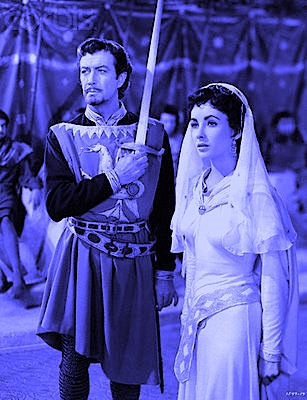
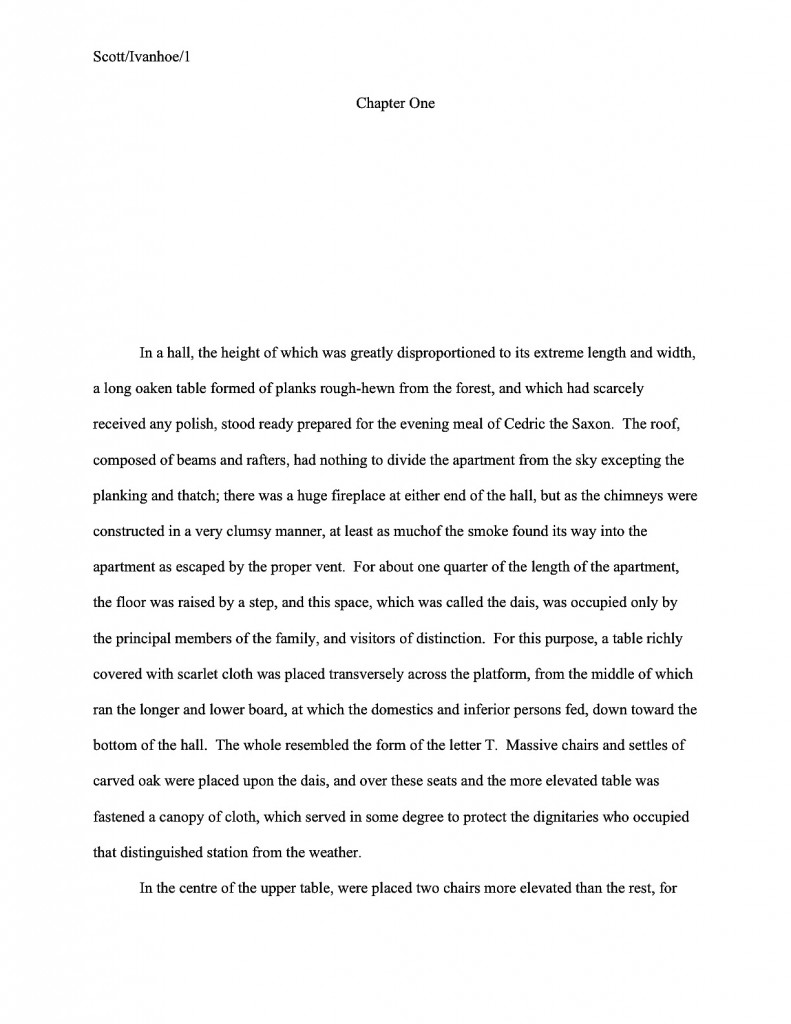

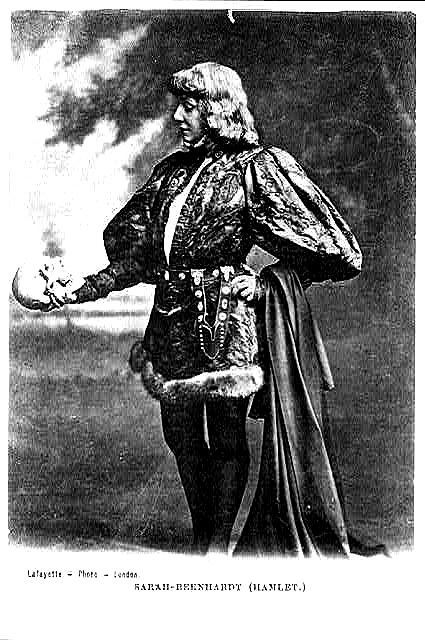







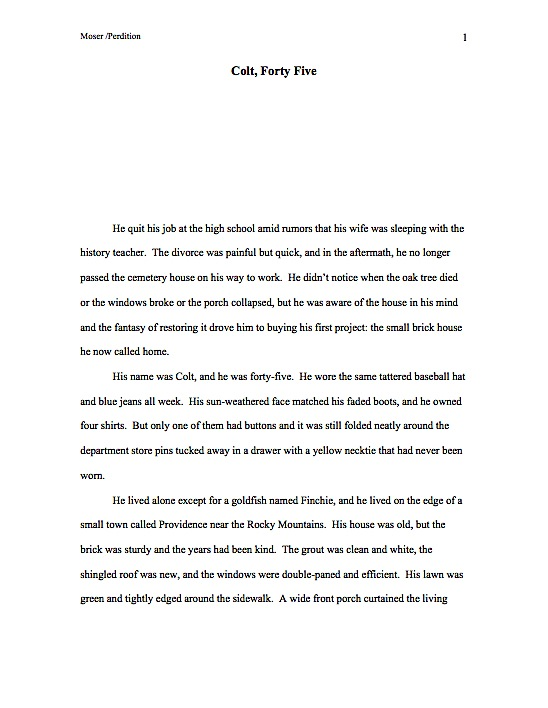

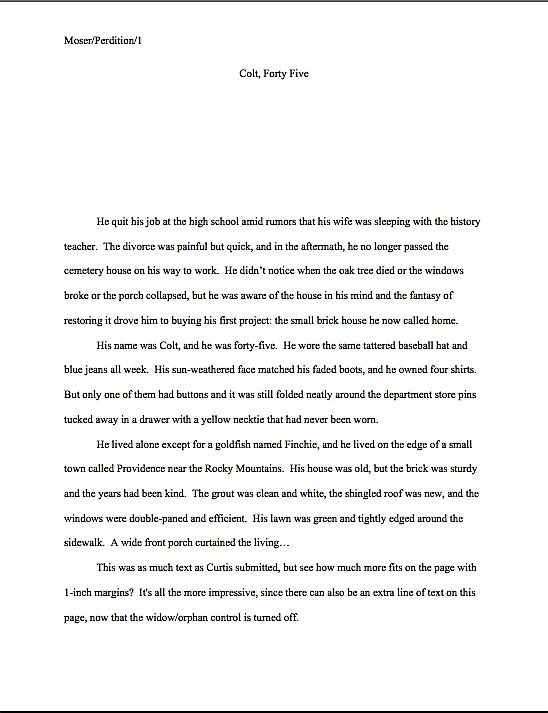


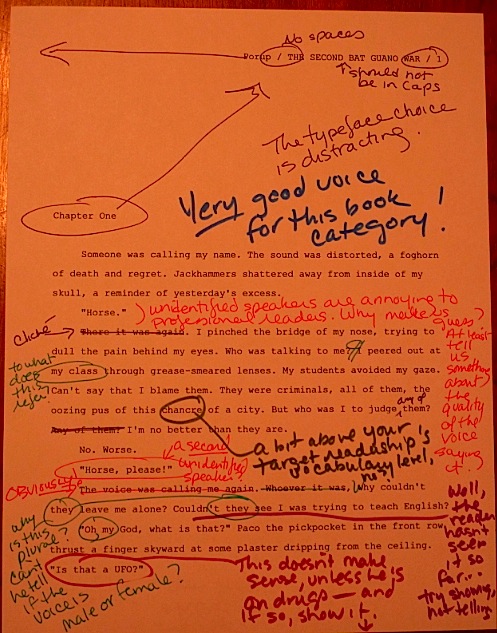

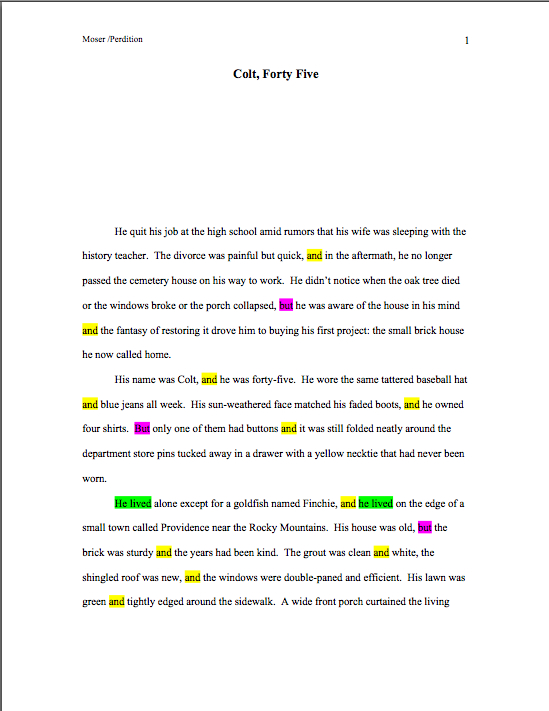

 Realistically, every English sentence a writer looking to sell a book places under an agent or editor’s nose is a writing sample: the query, the synopsis, the bio, the book proposal. Every paragraph is yet another opportunity to show these people that you can write.
Realistically, every English sentence a writer looking to sell a book places under an agent or editor’s nose is a writing sample: the query, the synopsis, the bio, the book proposal. Every paragraph is yet another opportunity to show these people that you can write.
